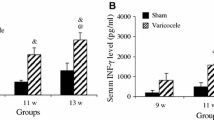Summary
In this study transforming growth factorβ (TGF-β)-like activity in human hydrocele fluid was investigated. Inhibition of DNA synthesis of adult rat hepatocytes in primary culture and stimulation of colony formation of normal rat kidney (NRK) fibroblasts, clone 49F in soft agar were observed in all acidified hydrocele fluids and these activites were neutralized by the specific antibody raised against human native TGF-β. In samples obtained from recurrent cases of hydrocele, TGFβ-like activity was observed in its active form (without acidification). These results suggest that human hydrocele fluid contains TGFβ-like activity and that the active form of TGF-β in recurrent hydrocele fluid may be responsible for the recurrence of the disease even after repeated aspiration.
Similar content being viewed by others
References
Carr BI, Hyashi I, Branum EL, Moses HL (1986) Inhibition of DNA synthesis in rat hepatocytes by platelet derived type-β transforming growth factor. Cancer Res 46:2330
DeLarco JE, Todaro GJ (1978) Growth factors from murine sarcoma virus-transformed cells. Proc Natl Acad Sci USA 75:4001
Fava R, Olsen N, Oja K, Moses H, Pincus T (1989) Active and latent forms of transforming growth factor β activity in synovial effusions. J Exp Med 169:291
Hirai R, Yamaoka K, Mitsui H (1983) Isolation and partial purification of a new class of transforming growth factors from an avian sarcoma virus transformed cell line. Cancer Res 43:5742
Huggins CB, Entz FH (1931) Absorption from normal tunica vaginalis testis, hydrocele and spermatocele. J Urol 25:447
Lyons MR, Oja JK, Moses HL (1988) Proteolytic activation of latent transfroming growth factor-β from fibroblast-conditioned medium. J Cell Biol 106:1659
Miyazono K, Heldin CH (1989) Role of carbodydrate structures in TGF-β1 latency. Nature 338:158
Miyazono K, Hellman U, Wernstedt C, Heldin CH (1988) Latent high molecular weight complex of transforming growth factor β1 purification from human platelets and structural characterization. J Biol Chem 263:6407
Moses HL, Tucker RF, Leof EB, Coffey RJ, Halper TrJ, Shipley GD (1985) Type-β transforming growth factor is a growth stimulator and a growth inhibitor. Cancer cells 3/ Growth factor and Transformation. Cold Spring Harbor Lab., New York, p 65
Moses HL, Coffey RJ, Leof EB, Lyons RM, Keski-Oja J (1987) Transforming growth factor β regulation of cell proliferation. J Cell Physiol [Suppl] 5:1
Nakamura T, Tomita Y, Hirai R, Yamaoka K, Kaji K, Ichihara A (1985) Inhibitory effect of transforming growth factor-β on DNA synthesis of adult rat hepatocytes in primary culture. Biochem Biophys Res Commun 133:1042
Nakamura T, Teramoto H, Tomita Y, Ichihara A (1986) Two types of growth inhibitor in rat platelets for primary cultured rat hepatocytes. Biochem Biophys Res Commun 134:755
Nakamura T, Arakaki R, Ichihara A (1988) Interleukin-1β is a potent growth inhibitor of adult rat hepatocytes in primary culture. Exp Cell Res 179:488
Owens GK, Geisterfer AAT, Young YWH, Komoriya A (1988) Transforming growth factor-β induced growth inhibition and cellular hypertrophy in cultured vascular smooth muscle cells. J Cell Biol 107:771
Pircher R, Lawrence DA, Jullien P (1984) Latent β-transforming growth factor in nontransformed and kirsten sarcoma virustransformed normal rat kidney cells, clone 49F. Cancer Res 44:5538
Ranganathan G, Lyons R, Jiang NS, Moses H (1987) Transforming growth factor type β in normal human urine. Biochem Biophys Res Commun 148:1503
Roberts AB, Frolik CA, Anzano MA, Sporn MB (1983) Transforming growth factors from neoplastic and nonneoplastic tissues. Fed Proc 42:2621
Sairenji M, Suzuki K, Murakami K, Motohashi H, Okamoto T, Umeda M (1987) Transforming growth factor activity in pleural and peritoneal effusions from cancer and non-cancer patients. Jpn J Cancer Res 78:814
Savage CR, Cohen S (1972) Epidermal growth factor and a new derivative. Rapid isolation procedures and biological and chemical characterization. J Biol Chem 247:7609
Seo MK, Lynch KE, Podolsky DK (1988) Multiplicity of transforming growth factors in human malignant effusions. Cancer Res 48:1792
Sporn MB, Roberts AB, Wakefield LM, Assoian RK (1986) Transforming growth factor-β: biological function and chemical structure. Science 233:532
Tanaka K, Sato M, Tomita Y, Ichihara A (1978) Biochemical studies on liver functions in primary culture hepatocytes of adult rats. Hormonal effects on cell viability and protein synthesis. J Biochem [Tokyo] 84:937
Twarzik DR, Sherwin SA, Ranchalis J, Todaro GJ (1982) Transforming growth factors in urine of normal, pregnant and tumor-bearing humans. JNCI 69:793
Wakefield LM, Smith DM, Masui T, Harris CC, Sporn MB (1987) Distribution and modulation of the cellular receptors for transforming growth factor-beta. J Cell Biol 105:965
Author information
Authors and Affiliations
Rights and permissions
About this article
Cite this article
Saha, P.K., Kanda, S., Morimitsu, H. et al. Transforming growth factor β-like activity in human hydrocele fluid. Urol. Res. 18, 295–298 (1990). https://doi.org/10.1007/BF00294778
Accepted:
Issue Date:
DOI: https://doi.org/10.1007/BF00294778




